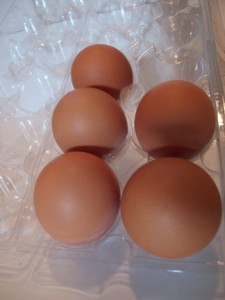NC State University has a short video and interesting website, which gives some good reasons why to use native plants when landscaping. They give resources for where to find plants native to North Carolina. You can click here to see a list of New York State native plants.
Category Archives: urban farming
More backyard chicken eggs
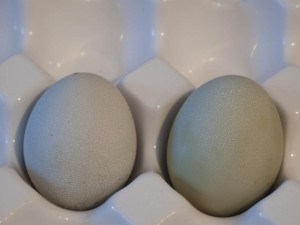
2nd egg
Yesterday I got the second egg from my hen Lulu. In Europe when you go to buy eggs, you don’t find them in the refrigerated section of the grocery store. They sit in big open cartons on the shelf. This makes most Americans squeamish about bacteria, salmonella, and anything else that could make them sick. It’s pretty cold in my apartment, so I think I’m somewhere in the middle of this debate by having them on my kitchen table. I may re-think this in the summer.
I have to admit that I’m having a hard time thinking about eating these eggs. Part of it is the novelty of them. They are pretty, little greenish-gray objects. I hate to admit that I have been so programmed to buy brown or white eggs from a carton in the grocery store, that I’m feeling a little squeamish. Eggs from my backyard? Seems as unlikely as picking fruit off one of my trees. I have been working so hard not to have this cultural programming in my daughter by planting blueberry bushes at her grandparent’s house, going to goat farms, picking wild raspberries and blackberries, eating icicles. She wants me to make her scrambled eggs with these eggs already! I think she will help me get over the preciousness and oddity of homegrown eggs.
Mother Earth News has been testing the nutrients of pastured eggs compared with those of commercial eggs. Pastured eggs meaning that they are eggs from hens that are allowed to roam and supplement their grain-based diet with plants such as grass and insects. Eating plants adds beta carotene to their diet and eating insects benefits almost everyone else.
The pastured eggs contained:
1/3 less cholesterol
1/4 less saturated fat
2/3 more vitamin A
2 times more omega-3 fatty acids
3 times more vitamin E
7 times more beta carotene
That’s pretty impressive. I think I’ll make Lindsay those eggs for breakfast tomorrow!
My first egg!!!
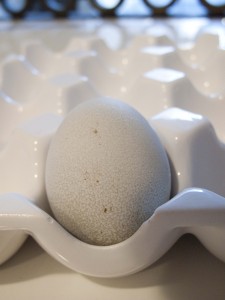
1st egg
Imagine my surprise when I saw a little blue/green egg sitting next to the golf ball. (You put a golf ball or other round object in the next box to give them a subtle hint as to where to lay their eggs) By process of elimination, I think it was Lulu who laid the egg. Andy should lay white eggs, so it was either Lulu or Edie. Lulu’s comb is a much darker red than Edie’s. When hens mature and are ready to lay, their combs turn bright red. So I think Lulu’s the one. I feel like a proud mommy.
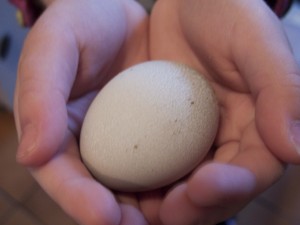
Public Meeting on Rising Sea Levels
Have you ever wondered what NYC is going to look like if the polar ice caps keep melting? Will my neighborhood in Brooklyn be waterfront property, or even underwater? Well apparently New York State has been giving it some thought. I just saw a listing for a public meeting on Rising Sea Levels and it is for today in Manhattan.
The public is invited to a series of meetings about the effects of sea level rise and development of recommendations for adapting to rising sea levels. The meetings, sponsored by the New York State Sea Level Rise Task Force, will be held at Department of Public Service Board Room, 4th Floor, 90 Church St., Manhattan.
The meetings are an opportunity for interested members of the public to provide input to the work plan for the task force and various associated work groups. Each meeting will consist of an informal open house, followed by staff presentations and opportunity for public comment.
The open house will include exhibits related to various aspects of climate change and sea level rise. Agency staff will be available to explain the exhibits, answer questions and hear any comments that participants may have. Those interested may come at any time during the scheduled open house. Agency staff will make several presentations at the scheduled times. Opportunity for participants to ask questions and provide comments will follow the presentations.
New York City Meeting:
Department of Public Service Board Room, 4th Floor, 90 Church St., Manhattan
2:00 p.m Open House
6:00 p.m Welcome and Introduction
6:10 p.m Sea Level Rise Task Force Overview and Opportunities for Involvement
6:20 p.m Climate Change and Sea Level Rise Projections
6:50 p.m Projected Impacts and Proposed Scope of Recommendations: Ecosystems and Natural Resources
6:55 p.m Projected Impacts and Proposed Scope of Recommendations: Infrastructure and Community Resilience
7:00 p.m Questions and Answers
Public Comment Session
Obama's Inauguration Speech
I think I speak for many people all over the world when I say that I am so unbelievably hopeful at this time in American history. The last 8 years seemed to be one disappointment after another. Perhaps disappointment is too light a word. It was a time that I wasn’t proud to be living in this country.
It is a great testament to the people that we were able to recognize how low we had gotten as a country and make a drastic change. Although Obama has a huge job in dragging this country out of an economic, political, healthcare, and environmental crisis, I think he’s up for the job.
I am especially hopeful that he will make strides towards renewable energy. To me, one of the saddest moments was when Ronald Reagan tore down the solar panels from the White House that Jimmy Carter had installed. I’m crossing my fingers that the Obamas put them back up!
U.S. City Dwellers Flock to Raising Chickens
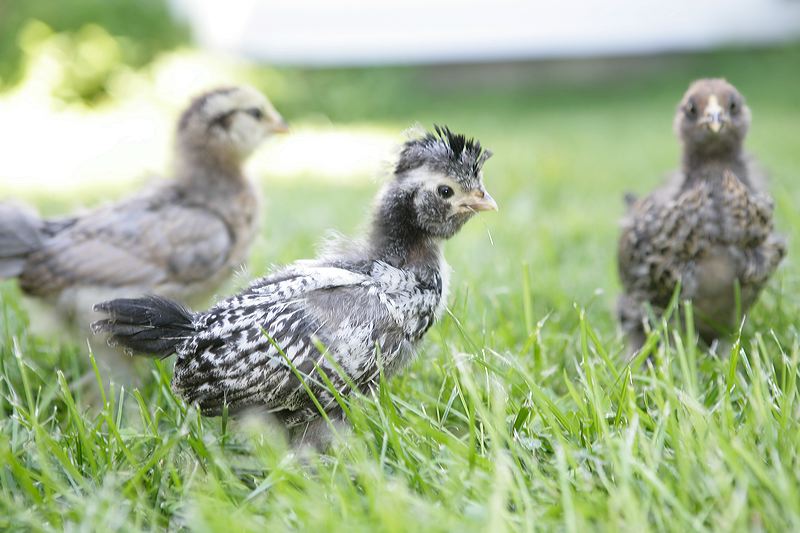
by Ben Block on October 6, 2008
They arrived when a member of BackyardChickens, an online forum, ordered the birds in the mail this past May. “I actually get my chicks in today hopefully, and I am worried that animal control will be at the post office waiting for me with hand-cuffs,” the new poultry farmer wrote.
An underground “urban chicken” movement has swept across the United States in recent years. Cities such as Boston, Massachusetts, and Madison, Wisconsin, are known to have had chickens residing illegally
behind city fences.
But grassroots campaigns, often inspired by the expanding movement to buy locally produced food, are leading municipalities to allow limited numbers of hens within city limits.
Cities such as Anne Arbor, Michigan; Ft. Collins, Colorado; and South Portland, Maine have all voted in the past year to allow residents to raise backyard poultry. "It’s a serious issue – it’s no yolk,” said Mayor Dave Cieslewicz of Madison, Wisconsin, when his city reversed its poultry ban in 2004. “Chickens are really bringing us together as a community. For too long they’ve been cooped up.”
Raising backyard chickens is an extension of an urban farming movement that has gained popularity nationwide. Home-raised livestock or agriculture avoids the energy usage and carbon emissions typically associated with transporting food.
“Fresh is not what you buy at the grocery store. Fresh is when you go into your backyard, put it in your bag, and eat it,” said Carol-Ann Sayle, co-owner of five-acre (two-hectare) farm in Austin, Texas, located within walking distance from the state capitol. “Everyone should have their own henhouse in their own backyard.”
“Buying local” also provides an alternative to factory farms that pollute local ecosystems with significant amounts of animal waste – which can at times exceed the waste from a small U.S. city, a government report revealed last month. In the United States alone, industrial livestock production generates 500 million tons of manure every year. The waste also emits potent greenhouse gases, especially methane, which has 23 times the global warming potential of carbon dioxide.
Meanwhile, advocates insist that birds raised on a small scale are less likely to carry diseases than factory-farmed poultry, although some public health officials are concerned that backyard chickens could elevate avian flu risks.
Chicken: The ‘Buy Local’ Mascot
After the trend first gained popularity in London, England, with the invention of the “eglu” chicken house about ten years ago, large numbers of city dwellers began to raise chickens in the U.S. cities of Seattle and Portland, said Jac Smit, president of the Urban Agriculture Network. “It’s no longer something kinky or interesting,” Smit said. “The ‘chicken underground’ has really spread so widely and has so much support.”
Within the past five years, the trend has expanded to cities where raising hens was already legal, including Los Angeles, San Francisco, and Chicago.
“Chicken has become the symbol, a mascot even, of the local food movement,” said Owen Taylor of New York City, who knows of at least 30 community gardens that raise poultry, mostly for their eggs. One Brooklyn home has raised upward of 50 hens. “We’re the biggest city in the country, so to have it here I think blows people’s minds.”
K.T. LaBadie, a University of New Mexico graduate student, was born into a family that grew its own fruits and vegetables. So when she moved to Albuquerque and met a friend who was raising his own chickens, poultry was a logical progression in her own home. She began with two hens, and now she has four.
“It felt like a good compliment to our backyard gardening. We get compost from the chickens that goes back into the vegetable beds,” LaBadie said. “And there’s really nothing better than harvesting tomatoes and peppers from your garden and being able to make an omelet with it using a meal that was based in your backyard.”
The spread of backyard chickens has promoted spin-off businesses that cater to the local market. Some communities are relying on mobile slaughterhouses to manage and distribute the poultry meat, according to Smit. “It’s no longer huge slaughterhouses doing millions [of birds]. It’s a guy driving around on a truck, visiting neighborhood to neighborhood,” he said. “And it’s not chickens only…. Ducks, turkey, and quail are particularly attractive.”
In Portland, Oregon, residents have organized a farming cooperative to raise hens for egg production. “The money is used to maintain the cooperative. It’s not necessarily organized to be a profit-sharing venture,” said Debra Lippoldt, executive director of Growing Gardens, a Portland urban agriculture advocacy group.
Public Health Concerns
If avian influenza eventually evolves to infect humans, experts fear that backyard chickens will be vectors of the disease. Government officials have threatened to ban free-range chickens in cities in Thailand, Indonesia, and Hong Kong, where bird flu has spread in the past. Governments around the world are also concerned that wild fowl will infect backyard chickens, leading to calls for similar bans in the Canadian province of British Columbia and in Australia.
But several public health officials argue that homegrown poultry are not a disease threat if the chickens are properly maintained. “Make sure the roof of the pen has a solid cover to protect birds from fecal matter that may drop from birds flying overhead,” said University of California at Davis poultry specialist Francine Bradley in a statement released in 2005, at the peak of avian flu concerns. “We always tell people, don’t let anyone near your birds who doesn’t need to be there [due to fears of people carrying the virus].”
Sustainable farming advocates insist that backyard chickens are less of a concern than factory-farmed poultry, which the Pew Commission on Industrial Farm Animal Production has said poses serious risks of transmitting animal-borne diseases tohuman populations, especially due to the prevalence of antimicrobialresistance.
“When it comes to bird flu, diverse small-scale poultry farming is the solution, not the problem,” the international sustainable agriculture organization GRAIN concluded in a 2006 report.
For urban poultry farmers, a more relevant health issue is whether the chickens, which many owners consider to be pets, can survive urban wildlife, even in New York City. “It’s awful how often flocks are decimated by raccoons or hawks or possums,” said Owen Taylor, who runs the City Farms livestock program, an extension of the sustainable food organization Just Food.
As the backyard chicken movement spreads, urban farmers are finding new ways of experiencing city living, whether their chickens are pets or dinner. “Raising chickens on a backyard stoop, especially if you have children, is agreeable,” Smit said. “How you convince the kids you’ll cut its neck and eat it is another thing.”
Ben Block is a staff writer with the Worldwatch Institute. He can be reached at bblock@worldwatch.org.
12 Ways to Use Spent Coffee Grounds
Trish Smith over at The Daily Green posted about 12 ways to recycle used coffee grounds. Instead of throwing them out, try the following:
Christmas Trees
In an effort to offset some of the holiday excess, why not mulch your Christmas tree? In NYC they call it mulchfest and set up wood chippers in various parks across the city. You bring your tree there and they turn it into mulch. I usually drag a few trees I run across on my way to the park as well. I find the sight of abandoned Christmas trees to be very sad, especially if they have tinsel on them. If you are in NYC, you can look here to find out when and where to bring your tree. It’s this coming weekend near me. If you don’t live in NYC, there seem to be programs all over the place. I would start by contacting your department of sanitation to see what they are doing.
Egg Carton Labels
I think most people can agree that a hen that gets to walk around lives a more pleasant life than a hen that lives in a tiny cage. When you go to the grocery store it is hard to sift through the different egg carton labels to determine which eggs are the best for you.
Here is a brief description of the different labels compiled with the help of the Humane Society’s publication on egg carton labeling. Only 3 labels show an adherence to official, audited guidelines. Those labels will be shown underlined. Although there are guidelines for what the hens eat, there really aren’t audited guidelines for how they are treated. California just passed a prevention of cruelty to farm animals, which gives hope that other states will follow. It could also be incentive to have backyard hens of your own!
- Certified Organic – Organic hens are fed vegetarian, organic feed that is free of antibiotics and pesticides. The hens live barns and warehouses (and not in cages) and are required to have access to the outdoors. If you read The Omnivore’s Dilemma, you will come to understand that the gray area here is the term “access to the outdoors”. The outdoors can mean a beautiful pasture or a paved area. The farmers can keep the chicks strictly indoors fortheir first 5 weeks of life, after which they open the barn doors. At this point the chickens are so used to life indoors that they are often too afraid to venture outside. Beak cutting and forced molting (via starvation) are allowed.
- Free-Range/Free-Roaming – There are no USDA standards for “free-range” egg production. They aren’t caged, but are subject to the same conditions as above and there’s no standards as to how many chickens are in stocked in a given space. There are no standards as to what the birds are fed. Beak cutting and forced molting (via starvation) are allowed.
- Certified Humane – These hens are kept out of cages, but may be indoors all the time. They have to be allowed to perform what comes naturally to them such as dust bathing, perching and nesting. There are requirements as to stocking density, number of nest boxes and perches. Debeaking is allowed, but forced molting isn’t.
- Cage Free – These birds are kept out of cages, but may be indoors all the time. They are able to do some of what comes naturally to them (walking, spreading their wings and nesting). Debeaking and forced molting are permitted.
- Vegetarian-Fed – These birds are fed a diet that doesn’t include any recycled animals. However, there are no guidelines for their housing and care.
- Natural – There is no legal definition of “natural”. Any food that doesn’t contain artificial ingredients or added color, and is minimally processed is considered “natural”
- Omega-3 Enriched – This usually means that the hens were fed extra flax seed causing their eggs to be higher in Omega 3s. There are no guidelines for their housing and care.
- Fertile – The eggs were laid by hens who come into contact with roosters, which generally means they weren’t caged.
- United Egg Producers Certified – This is a voluntary program that most egg farmers comply with. It permits cruel and inhumane practices. The hens are given 67 square inches of space each, which isn’t enough for them to perform their natural behaviors (stretching their wings, walking, etc.). They are allowed to debeak the hens, but forced molting through starvation isn’t allowed. Compliance is verified through 3rd party auditing.
Snow in Brooklyn
We had a couple of inches of snow yesterday with some freezing rain. New York City is beautiful and magical for about the first hour after a snow. Then the streets turn to gray slush, with sub-zero salt water lagoons at every corner. My back garden, however, still looks pretty.
When I went out to feed the chickens this morning, there were little bird and squirrel footprints all across the snow.


